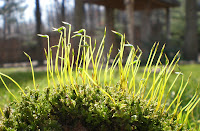Moss is Greening-up in PA Lawns
March 24, 2010 in Extension

Moss is one of the first plants to green-up in Pennsylvania lawns during early spring, and many homeowners consider it an annoying weed. Many different species of moss can grow and persist in home lawns. Unlike seed-bearing plants, mosses produce spores that can be wind-blown from one area to another and germinate to form thread-like structures called protonemas. The protonemas will produce buds that develop into the short, leafy stalks that most people recognize as moss. Moss is an opportunistic plant that will develop and grow in bare soil areas or where turfgrasses are weak and thin. Moss does not “crowd out” turfgrasses, but once it is established, grass plants will not spread into those areas.
In order to obtain effective control of moss, carefully consider the reasons why it began to grow in the lawn. Attempts to eradicate moss from a lawn are rarely effective unless provisions are made for a dense, actively-growing turf to take its place.
Encroachment of moss into lawns is usually the result of conditions that are not conducive to good growth of turf. Moss is most commonly associated with shallow, rocky soils; poor soil fertility; low soil pH (acid soils); heavy shade; and excessive moisture. If any of these factors are limiting turf growth, moss can invade the lawn and establish a permanent residence.
The first step in a moss control program is to test the soil for nutrient content and pH. Soil test kits are available from your county cooperative extension office for a nominal fee. If the soil is deficient in nutrients or in need of liming, the soil test report will indicate how much fertilizer and lime to apply and when to apply them. Over time, the improved soil conditions resulting from fertilizer and lime applications will help the turfgrasses compete with the moss.
If shade and/or moisture are the limiting factors for good turf growth, steps should be taken to correct the situation or plant grasses that are adapted to shaded or moist areas. The fine fescues are the best-adapted turfgrasses to shaded, well-drained soils, whereas, rough bluegrass is better adapted to shaded, moist soils. Neither species will survive under heavy shade or soils that are saturated for long periods of time. Only when the limiting factors for good turf growth have been corrected should moss eradication with chemicals be attempted.
Unfortunately, there are very few products that can be used to control moss. Products containing fertilizer and iron sulfate are sold at retail garden centers and can turn moss black and sometimes reduce encroachment. Other products may be available that contain salts that will dehydrate or “burn” the moss. Unfortunately, they also can burn desirable turfgrasses if used improperly. Be sure to follow label directions so that these products are used safely and correctly.